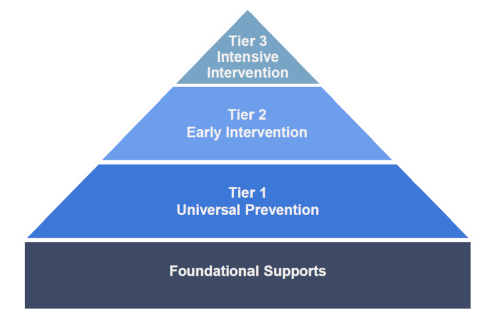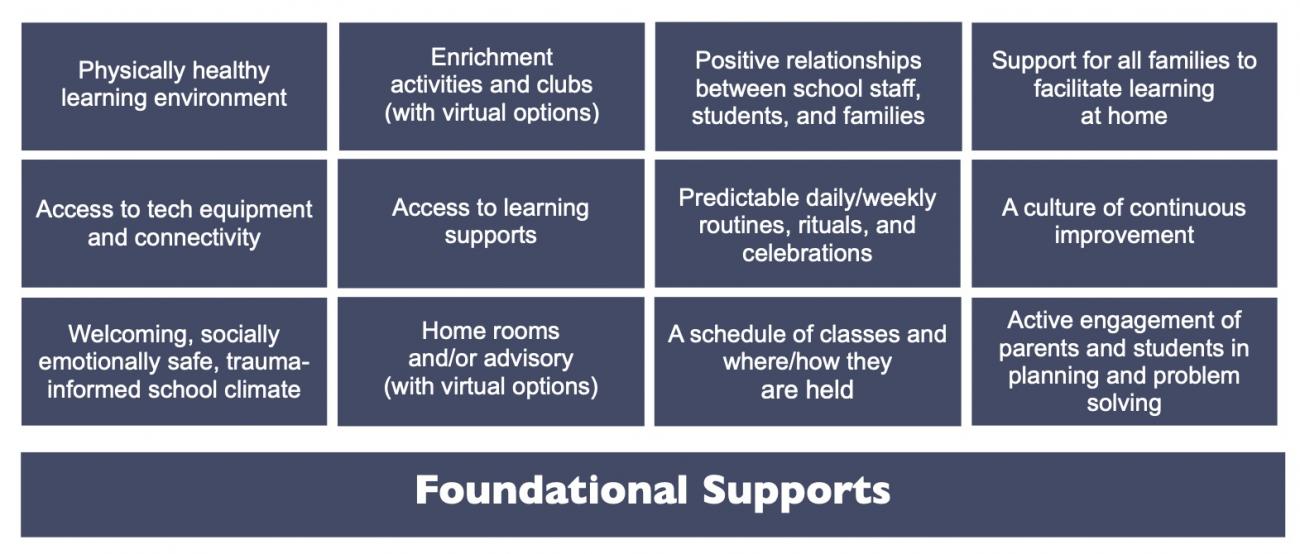A Tiered Approach to Ensuring Students Are Present, Engaged, and Supported in the 2020–21 School Year

Introduction
As schools begin this fall, educators across California are examining how they can promote students showing up for class, whether instruction is offered remotely or in person. In our previous PACE commentary, we made recommendations for expanding the metrics used to monitor daily attendance and participation in distance learning. In this commentary, we make recommendations for how educators can respond to student attendance data to ensure students get the support they need to be present and engaged in learning.
Absences Signal the Need for Additional Supports
When students miss school, it is a sign that positive conditions of learning (physical and emotional health and safety, a sense of belonging, an affirming environment, connection and support, academic challenge and engagement, and adults and peers with the competency to support these conditions) are not in place for students, their families, and sometimes an entire school community. This holds true at every grade level.
Data on absenteeism, contact information, connectivity, and attendance can help to identify individual students, particular student groups, or schools in need of additional support as well as to anticipate the level of resources needed to put positive conditions for learning in place. A greater investment is needed to ensure students with the highest levels of absences—such as those unable to afford access to the internet or who have lost a family member due to COVID-19—are feeling healthy and safe, and experience a sense of belonging in their school or classroom community.
A Multi-Tiered Approach Can Support Student Attendance and Engagement
Accurate, actionable, and available data on attendance and absenteeism can be used to inform a multi-tiered approach in response to absenteeism that puts in place conditions that motivate and support student attendance and participation. The idea behind a multi-tiered approach is that the majority of students will respond to school-wide strategies for improving attendance and engagement (known as Tier 1 supports) but that these strategies won’t be sufficient for all students: some students require more personalized support (Tier 2) and an even smaller number may need more intensive measures (Tier 3) taken on their behalf to reengage them with school.
In addition to being considered best practice, California’s Learning Continuity Attendance Plans require Local Education Agencies (LEAs) to take a tiered approach to reengagement in response to absences during distance learning. If students miss more than three school days or 60 percent of the instructional days in a week, LEAs must verify contact Information, notify parents or guardians of absences, and have a plan for outreach to determine student needs, including connection with health and social services.
Figure 1. Tiered Interventions and Foundational Supports


Building upon this solid foundation, our Attendance Playbook and Guide can help districts and schools reflect upon what is possible to engage and prevent absences for all students. It shares how to modify Tier 1 strategies such as threshold greetings, home visits and restorative practice to a virtual or physically distanced setting. Given the pandemic, the playbook also highlights the importance of physical health and nutrition through investments in healthy school buildings, school-based health services, telehealth, and breakfast for all. (Access to basic necessities can be found through the School Meal Finder, California Food Banks or local United Way 211 system.) In addition, given the need to take a trauma-informed approach, leaders might consider these SEL resources or PBIS Tier 1 strategies that have been adapted for distance learning to foster positive relationships and create a welcoming virtual school climate. Districts should also ensure that notifications to families about absences avoid a punitive tone and align with effective communication guidelines, including those from a new study that revealed the value of offering personalized attendance data, log-in information, and support during distance learning.
Identifying and Supporting Students With an Increased Level of Need
We recommend tracking and monitoring an expanded set of attendance metrics in order to identify students and subgroups in need of outreach and to offer additional support as early as possible. While there is no research-based benchmark for the level of absence that puts students at risk during distance learning, based on what we know from research conducted prior to COVID-19, missing 10 percent or more of in-person school is an early warning sign of disengagement. For this reason, our common sense answer is to monitor those students who are absent from 10 percent of distance learning days (2 or more days each month) by using a variety of data sources to understand engagement patterns and talking with families and students to understand the actual reasons for absence—as well as by developing tiered approaches to supporting them.
Tier 2 supports. Based upon research and experience prior to COVID-19, we recommend providing Tier 2 supports to students who missed between 10–20 percent of school during the last year before school closures as well as those who miss 10–20 percent of school over the course of a month or 60 percent of a week during the current year. Research-based strategies for supporting these students include:
- Pro-active and positive outreach: As soon as contact appears to be lost, schools should take immediate action to ensure the student is located and their contact information confirmed, and then implement proactive strategies for finding students and families.
- Additional tech support and training: The digital divide is a major barrier to students showing up to class, especially as the majority of students are still engaged in distance learning. In addition to offering access to technology as a prevention-related measure, schools and their partners should take steps to provide access to one-on-one technical support when lack of a computer, internet, or capacity to log into a system emerge as barriers.
- Expanded learning programs: Schools can help students by making sure they enroll and participate in an expanded learning program—which, research shows, significantly improves attendance during the school day, especially for English language learners. Even when school buildings are closed, many expanded learning programs are finding ways to offer enrichment and engagement virtually.
- Mentoring: Mentoring is a proven strategy for reducing absenteeism. The National Mentoring Partnership, in collaboration with partners, has released the Virtual Mentoring Portal. This free tool provides safe and monitored mentoring platforms for mentors and mentees to continue their relationships while they may be separated due to COVID-19.
- Mental health: Many LEAs anticipate the need for greater levels of mental health supports given the stress and impacts on students and families since school closure. The California Department of Education and health organizations such as Kaiser Permanente’s Planning for the Next Normal at School playbook offer ideas to expand services.
- Student attendance review teams and individual learning and attendance plans: Schools in California are already required to hold a student attendance review team (SART) meeting for students who have received multiple truancy (unexcused absences) notifications. We recommend expanding such meetings to support families even if absences are excused. Schools should use this opportunity to partner with students and families to craft plans that outline what engages the student in learning, addresses barriers to getting to class, builds upon family strengths, and supports ongoing monitoring of attendance data. Ensuring students and families have a voice in crafting plans is critical to tailoring solutions to their realities and nurturing ownership.
- Use continuous improvement processes to assess and modify interventions as needed: When implementing a strategy like proactive early outreach, monitor whether school staff are actively able to reconnect with families, and identify barriers to attendance. If staff are unable to locate students who have not signed in or shown up, additional methods of outreach may be necessary, including those specified in Tier 3.
Tier 3 supports. Tier 3 supports may be needed to improve outcomes for students who were severely chronically absent (missing 20 percent or more of school) prior to school closure, for those who did not show up during the first few weeks of school, or for those experiencing homelessness and/or who are involved in the foster care or juvenile justice systems. To offer these intensive supports, districts often collaborate with agencies that might have current or past contact with a family and secure the resources of additional community partners to address identified gaps. Ideally, such support would begin as soon as possible to ensure the year starts on a positive note. This can include:
- Student attendance review boards: These are mandated in California if a SART team meeting does not result in a reduction in truancies. Operating at the county or local level, Student attendance review boards (SARBs) are multidisciplinary, drawing together a team from a broad array of student and family organizations that have resources to help address the range of challenges that prevent a student from attending school. Counties or districts that do not yet have a SARB can contact one of the model SARB programs to identify effective practices.
- Interagency advocacy and support: Students involved in the child welfare or juvenile justice system can attain their educational goals with the support of a team of champions working across schools, families, and public agencies. For example, the National Center for Youth Law's Compassionate Systems Framework provides a research-based model for agency collaboration and coordination to ensure that all young people involved in state systems are supported to attain their educational goals. Since the onset of COVID-19, the Compassionate Systems team has been working with districts to develop early warning and data tracking indicators that provide real-time alerts when youth are not signing on or are under-engaged in distance learning.
Conclusion
An effective tiered reengagement strategy is essential for schools to fulfill their mission to educate in the COVID era. As every educator knows, students learn best when their basic needs for food, shelter, safety, love, and connection are met. As this checklist for integrating attendance into the learning continuity plan (LCP) shows, it is also a critical component of a high-quality LCP in California. Leaders should select proven evidence-based strategies; thoughtfully assess staff capacity to implement priority strategies; meaningfully engage students and families in determining what resources are needed; and redeploy staff as needed so that students are present, engaged, and supported. Leaders can also adopt a community schools approach to expand available support for students and families.
Read the related commentary Measuring Daily Attendance and Participation During COVID-19: An Invaluable Tool for Reducing Educational Inequity here.
Hedy Chang is Executive Director and Cecelia Leong is Vice President of Programs at Attendance Works, which focuses on advancing student success to help close equity gaps by reducing chronic absence.


